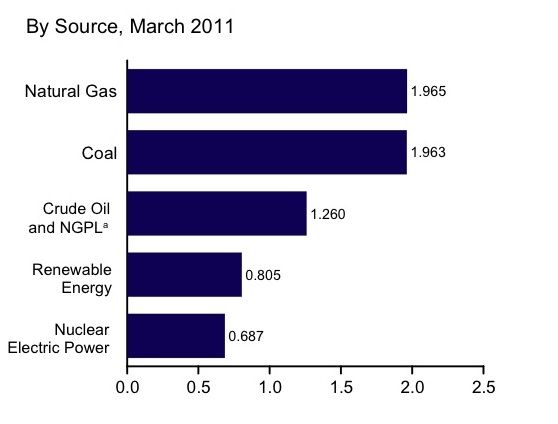The U.S. Energy Information Administration (EIA) released its most recent "Monthly Energy Review" and Electric Power Monthly last month.
According to these documents, renewable energy has passed a milestone: domestic production is now greater than that of nuclear power.
During the first quarter of 2011, renewable energy sources (note that this includes biomass/biofuels, geothermal, solar, water, wind) provided 2.245 quadrillion BTUs of energy, or 11.73 percent of U.S. energy production.
More significantly, energy production from renewable energy sources in 2011 was 5.65 percent more than that from nuclear power, which provided 2.125 quadrillion BTUs and has remained largely unchanged in recent years. Energy from renewable sources is now 77.15 percent of that from domestic crude oil production.
Looking at all energy sectors (e.g., electricity, transportation, thermal), production of renewable energy, including hydropower, has increased by 15.07 percent compared to the first quarter of 2010, and by 25.07 percent when compared to the first quarter of 2009. Among the renewable energy sources, biomass/biofuels accounted for 48.06 percent, hydropower for 35.41 percent, wind for 12.87 percent, geothermal for 2.45 percent, and solar for 1.16 percent.
Looking at just the electricity sector, according to the latest issue of EIA’s Electric Power Monthly, for the first quarter of 2011, renewable energy sources (biomass, geothermal, solar, water, wind) accounted for 12.94 percent of net U.S. electrical generation -- up from 10.31 percent during the same period in 2010. Non-hydro renewables accounted for 4.74 percent of net U.S. electrical generation.
In terms of actual production, renewable electrical output increased by 25.82 percent in the first three months of 2011 compared to the first quarter of 2010. Solar-generated electricity increased by 104.8 percent, wind-generated electricity rose by 40.3 percent, hydropower output expanded by 28.7 percent, and geothermal electrical generation rose by 5.8 percent. Only electricity from biomass sources dropped, by 4.8 percent. By comparison, natural gas electrical output rose by 1.8 percent and nuclear-generated electricity increased by only 0.4 percent, while coal-generated electricity dropped by 5.7 percent.
There are scores of charts in these reports; here are some of the most relevant:
Renewable Energy Consumption Compared With Other Resources

Still a long way to go...


Source: Charts from the most recent EIA report (units in quad BTUs)



